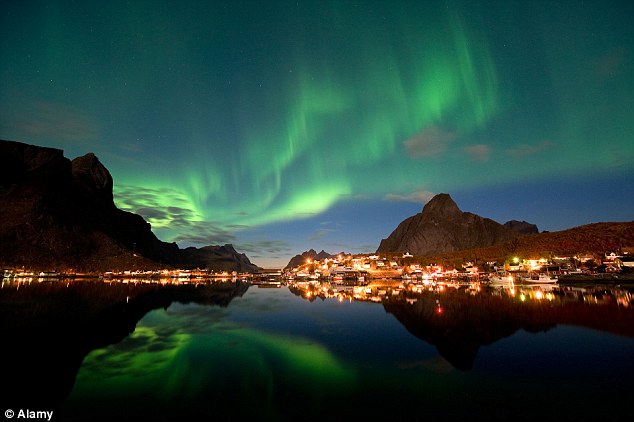The Earth will suffer
Based on the study of 84 stars, observing 29 solar flames, scientists concluded that super solar flares appear about every 350 years, which can break the grid, disable GPS and destroy satellites.
When will the earth be attacked by super sun flames?
Solar flares (solar flares - also known as solar storms) are bursts of radiation and particles that carry electric charge from the sun.
In 1859, a solar storm emitted from the sun was so powerful that northern light (Northern Lights) was visible in the far south as Cuba and the network. Wire mesh in some areas burning.

The solar storm that appeared in 1859 with such a powerful energy source that made northern light (like the lights at Reine, Norway shown in the figure) is also visible in the far south as Cuba.
In today's world, electronic devices exist everywhere, a similar eruption can wreak havoc, causing chaos because satellites and communication systems are disabled. .
When does the solar super fire appear?
Currently, astronomers have calculated that our sun-like star is expected to launch a spark (the same intensity that we saw in 1859) every 350 once a year.
While this seems to be good news for us because the last super fire only appeared 156 years ago, in theory a super fire could attack at any time.
Even a weaker solar fire could have caused Canada's entire province of Quebec's power cup in 1989.
According to Science magazine, astronomers at the Harvard-Smithsonian Center for Astrophysics in Cambridge, Massachusetts studied 84 sun-like stars , observing 29 solar sparks of similar intensity over a period of time. 4 years to determine the frequency of those sparks.
According to astronomers, a star like our sun is expected to emit a solar flare every 250 - 480 years, in which the prospect of every 350 years is most likely.
The team presented their findings on a poster at the International Astronomical Association Congress in Honolulu earlier this month.
 At the Astronomical Society Congress in Honolulu, astronomers believe that superflames that can disable the grid, GPS and satellites will attack the earth every 350 years.In the picture, dark spots on the sun's surface (sunspots) appear with solar flares.
At the Astronomical Society Congress in Honolulu, astronomers believe that superflames that can disable the grid, GPS and satellites will attack the earth every 350 years.In the picture, dark spots on the sun's surface (sunspots) appear with solar flares.
The flames the group studied were 10 times stronger than the fire that shot down Canada in 1989 and was 150 times stronger than the average solar flame.
Warning about the impact of super solar fire
Last month, the British government published a report warning that if a big solar storm broke out, we would only be alerted 12 hours before it struck.
The phenomenon of solar storms is expected to cause traffic congestion, causing power outages and disruptions to satellites.
The report warns that GPS systems may stop operating for up to three days, making the train and shipping network badly affected.
While mobile phones and landline phones are expected to be unaffected, high-frequency satellite and radio communications used in sea and air transport may also be suspended. some days.
The grid may also be affected, resulting in power outages in some areas.
The report warns that the most harmful element of extreme weather in space is the coronal mass ejection (CME) - where large eruptions release particles of energy. High quality into space.

The UK National Weather Service (Met Office) currently provides weather forecasts in aerospace to help the public and industry prepare for solar storms that could pose a risk. for infrastructure, as shown in the above graphic.
The report also warns that large solar flames - caused by the accumulation of magnetic energy sources that emit radiation streams throughout the solar system - can also pose risks.
"The weather in outer space comes from the sun's activity. The sun's activity can emit X-rays, high-energy particles and plasma aurora eruptions," the report said.
'If that activity goes to the earth, it will be able to cause widespread impacts.'
"These impacts include power outages, airline disruptions, loss of communications and disturbance of satellite systems."
While a steady stream of energy particles from the sun vibrates planets in the solar system - known as the solar wind - sparks and eruptions emit very strong radiation and energy particles. .
- What kind of catastrophe will people suffer if the Earth stops spinning?
- The meteorite hits Earth: 5 countries suffer losses
- The meteorite stabbed Earth, China suffered the most damage?
- Journey when people fall from the universe to Earth
- Vietnam may suffer a bad rainy season
- Meteors make the Moon destroy Earth?
- City Ho Chi Minh will be 'submerged' if the 2 pole ice melts
- Forget the dinosaurs, this is the most horrifying extinction in Earth's history
- Pregnant women often suffer from depression
- Pain relief for safe spinal anesthesia
- 10 interesting facts about Earth you may not know
- The 15 most isolated cities on Earth
 Van Allen's belt and evidence that the Apollo 11 mission to the Moon was myth
Van Allen's belt and evidence that the Apollo 11 mission to the Moon was myth The levels of civilization in the universe (Kardashev scale)
The levels of civilization in the universe (Kardashev scale) Today Mars, the sun and the Earth are aligned
Today Mars, the sun and the Earth are aligned The Amazon owner announced a secret plan to build a space base for thousands of people
The Amazon owner announced a secret plan to build a space base for thousands of people